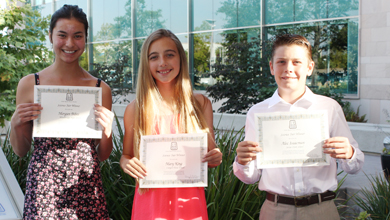-
Published: May 29, 2014 | 09:00 AM
Four Science Fair Winners Honored by Irvine Ranch Water District
Four Irvine Unified School District students who created water-related science fair projects were honored by the IRWD Board of Directors at their May 27 meeting.
The students were presented with certificates and each of their schools will receive $100 on their behalf for the science programs, with an additional $100 going to support the district science fair.
IRWD has participated in the science fair since its inception more than 20 years ago. In the fall, IRWD professionals participate in Ask-a-Scientist Night, which offers the students the opportunity to get their questions answered about their prospective projects.
This year’s science fair was held for the second year at Woodbridge High School. IRWD water quality experts Mindy Bergen and Michele Drzymowski judged more than 40 water-related projects based on the use of the scientific method, creativity, relevance, completeness of the project and evidence of problem solving.
This year’s winners:
- Mary King – “Colored Water: Pet’s Preference,” 6th grade, Canyon View Elementary School. Mary asked the question whether or not different colors placed in water would determine how much a pet would drink. She had heard that dogs and cats are color-blind, but wanted to do something to encourage her pets to hydrate more. Her research showed that some house pets could see variations of blue and yellow. She put out red, green, blue and clear water and watched the pets’ reactions. She hypothesized that the animals would gravitate to the blue water, based on her research. The pets’ second choice, she thought, would be clear water, followed by green, with red being the least preferred. She conducted her experiment over 10 days. Her conclusion was partially correct, in that the blue water was consumed quicker by the pets, but differed from her hypothesis because the red water was the pets’ second choice, followed by green, then clear.
- Alec Isaacman – “Osmotic Power,” 6th grade, Stone Creek Elementary School. Alec set out to determine what impact the salinity level of water has on the production of osmotic generated power. He constructed two chambers separated by an osmotic membrane and filled them with equal amounts of water – one fresh and one salt water. The experiment sought to determine the absorption rate of the salt water as it pulled the fresh water through the membrane. He believed the higher the salinity level, the faster would be the rate of absorption, thus, having the potential to produce energy more efficiently. His conclusion was correct because water with the higher salinity level caused a quicker absorption rate. Alec’s project went to the county competition, where it received a second place in its division and then onto state competition.
- Sandeep Kambhampati – “A Novel DNA Electrochemical Biosensor for the Detection of Heavy Metals in Aquatic Ecosystems,” 9th grade, University High School. Many heavy metals are suspected of having carcinogenic effects, but a clear connection is yet to be found. The goal of Sandeep’s experiment was to establish a connection by linking heavy metals such as lead, to structural deformation of DNA and oxidative stress. Cyclic voltammetry was used to investigate the oxidation peaks of the purine bases of DNA. The project then used the connection between heavy metals and DNA damage in a DNA electrochemical biosensor and sought to optimize the synthesis of biosensor. In conclusion, the experiment developed a clear correlation between lead nitrate and guanine oxidation, confirming that lead nitrate is most likely mutagenic. Sandeep’s project went to the county competition, where it won a second place in its division, then to the state competition, where the project brought home a third place award.
- Morgan Bibee – “Effectiveness of a coil-based water heating system through its ability to transfer thermal energy versus a traditional water heating system,” 10th grade, Woodbridge High School. Morgan’s experiment was to determine a new water heating system which would be more effective and energy-efficient than the traditional method. It was hypothesized that this new method would make use of thermal energy which would normally go to waste. It used copper coils to absorb thermal energy and recycle it into water passing through them. In conclusion, the traditional system did not change the temperature from the water source. Overall, the experiment proved that a coil-based water heating system is more effective than the traditional system.
More information about IRWD’s education programs is available on our website.



